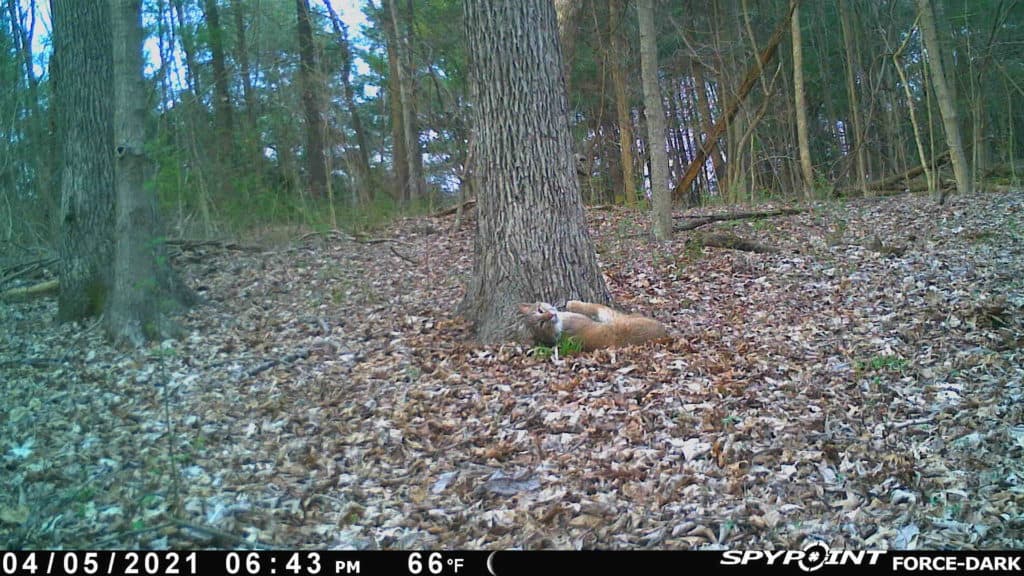Share this article
Coyotes and bobcats coexist
Coyotes and bobcats may occasionally come into conflict with one another in North America, but this doesn’t seem to affect the two species on a population level.
Wildlife managers had long assumed that when coyotes (Canis latrans) and bobcats (Lynx rufus) crossed paths, the slightly larger canines typically emerge victorious. Some managers even feared that coyotes may present an obstacle to bobcats repopulating parts of the U.S. where they were formerly extirpated.
But in recent research published in Mammal Review, scientists found little evidence that competition to the point of excluding bobcats from an area occurs on a population level.
“There is some truth to the thought that coyotes might outcompete bobcats given their often larger body size, but not to the degree people are worried about,” said TWS member Marissa Dyck, a PhD student at Ohio University and one of the co-authors of the review.

Coyotes are usually a little larger than bobcats, on average, though perhaps not as fierce. Credit: Marissa Dyck
Dyck, who specializes in bobcats, and her co-author and fellow Ohio University PhD student Eileen Wyza, who studies coyotes, combined forces to review all of the literature they could find in North America on how the two mesopredators interact on the landscape. Some of those studies included landscape-level population models. Others examined coyote and bobcat scat in the U.S. and Mexico to determine whether they were sharing the same prey items.
While average sizes of the two animals vary depending on their location in North America, coyotes, are usually a little bigger than bobcats. The canines typically weigh between 30 and 40 pounds, while the felines average 20 to 30 pounds.
“In general, I’d say that bobcats are fiercer,” Dyck added, noting that researchers have sometimes captured and collared coyotes without sedating them, but not bobcats.
The researchers found some trends in the data, though the type of ecosystem affected how the bobcats interacted. “Open habitats tended to have higher competition,” Wyza said, adding that this is likely due to less prey availability in open areas. Bobcats may also be out of their element in open areas, since they are ambush-style hunters. Coyotes, on the other hand, usually chase down their meals.

Bobcats typically prefer to hunt in the forest, where they can ambush their prey. Credit: Marissa Dyck
Landscape studies generally showed more potential competition between the predators where their home ranges overlapped. But scat analysis research revealed a more nuanced picture. While coyotes and bobcats shared some of the same prey items, evidence indicated that the two carnivores likely eat different prey items in areas where they overlap.
One study did show what may be the most direct evidence of competition between the species—bobcat hair turned up in coyote scat. But even then, it’s unclear whether the coyote actively hunted the bobcat, or whether it just scavenged it.
Another two incidents were reported in the literature of coyotes killing bobcats. In one, a bobcat was caught in a foot trap at the time, so Wyza notes it’s hard to draw any conclusions from that instance due to human interference. In another case, the predation occurred in a period of low prey availability when several other bobcats in the area also died of starvation. “It was a very extreme situation in which this interspecies killing was happening,” Wyza said.
The researchers found no evidence in the literature of bobcats preying on or scavenging coyotes, though the felines usually don’t scavenge.
Wyza said that one of the main takeaways of this review is the importance of using multiple tools like camera traps, diet analysis and habitat modeling to determine the level of competition between carnivores.
“Coyotes and bobcats, in general, seem to coexist relatively well,” Wyza said. “It’s something that needs to be monitored in some places, especially in Ohio where we’re trying to bring bobcats back.”
But all of the literature the researchers gathered suggests that the perception that coyotes will chase bobcats off the landscape isn’t necessarily true. Even in their personal experience tracking the carnivores in Ohio, the researchers have seen evidence of coexistence.
“We’ll see them in the exact location maybe an hour apart,” Dyck said.
Header Image: A bobcat in Ohio. Credit: Marissa Dyck








